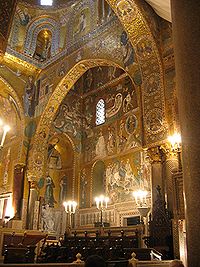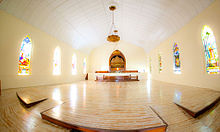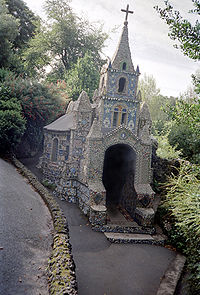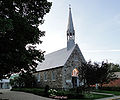- Chapel
-
For other uses, see Chapel (disambiguation).
 Littlejohn Memorial Chapel, an example of a school chapel at Scotch College, Melbourne
Littlejohn Memorial Chapel, an example of a school chapel at Scotch College, Melbourne
 Cappella Palatina (illustrated) and Palatine Chapel in Aachen are two most famous palatine chapels of Europe.
Cappella Palatina (illustrated) and Palatine Chapel in Aachen are two most famous palatine chapels of Europe.
 Celebration Chapel of Kingston, New York's historic Rondout district is a Wedding Chapel for gay/lesbian and straight weddings and weddings of mixed faiths and Atheists
Celebration Chapel of Kingston, New York's historic Rondout district is a Wedding Chapel for gay/lesbian and straight weddings and weddings of mixed faiths and Atheists
A chapel is a building used by Christians as a place of fellowship and worship. It may be part of a larger structure or complex, such as a church, college, hospital, palace, prison or funeral home, located on board a military or commercial ship, or it may be an entirely free-standing building, sometimes with its own grounds.[1] Many military installations have chapels for the use of military personnel, normally under the leadership of a military chaplain. Until the Protestant Reformation, a chapel denoted a place of worship that was either at a secondary location that was not the main responsibility of the local parish priest, or that belonged to a person or institution. Most larger churches had one or more secondary altars, which if they occupied a distinct space, would often be called a chapel.
The word chapel is in particularly common usage in the United Kingdom, and even more so in Wales, for independent or nonconformist places of worship; and in Scotland and Ireland for Roman Catholic churches. In the UK, due to the rise in popularity of independent or nonconformist chapels throughout the late eighteenth and early nineteenth centuries, by the time of the 1851 census, more people attended the independent chapels than attended the state's Anglican churches.
The word, chapel, like the associated word, chaplain, originally had Christian roots, but is used in a wider context today. While many are denominational, many are non-denominational. The latter are mostly encountered as part of a non-religious institution such as a hospital, prison or military installation. In England, where the Anglican Church is established by law, nondenominational or inter-faith chapels in such institutions may nonetheless be consecrated by the local Anglican bishop.
Chapels that are built as part of a larger church are holy areas set aside for some specific use or purpose: for instance, many cathedrals and large churches have a "Lady Chapel" in the apse, dedicated to the Virgin Mary; parish churches may have such a "Lady Chapel" in a side aisle or a "Chapel of Reservation" where the consecrated bread and wine of the Eucharist are kept in reserve between services, for the purpose of taking Holy Communion to the sick and housebound and, in some Christian traditions, for devotional purposes.
In Roman Catholic Canon Law, a chapel, technically called an "oratory" is a building or part thereof dedicated to the celebration of services, particularly the Mass, which is not a parish church. This may be a private chapel, for the use of one person or a select group (a bishop's private chapel, or the chapel of a convent, for instance); a semi-public oratory, which is partially available to the general public (a seminary chapel that welcomes visitors to services, for instance); or a public oratory (for instance, a hospital or university chapel).
Contents
History
The earliest Christian places of worship are now often referred to as chapels, as they were not dedicated buildings but rather a dedicated chamber within a building, such as a room in an individual's home. Here one or two people could pray without being part of a communion/congregation. People who like to use chapels may find it peaceful and relaxing to be away from the stress of life, without other people moving around them.
The word "chapel" is derived from a relic of Saint Martin of Tours: traditional stories about Martin relate that while he was still a soldier, he cut his military cloak in half to give part to a beggar in need. The other half he wore over his shoulders as a "small cape" (Latin: capella). The beggar, the stories claim, was Christ in disguise, and Martin experienced a conversion of heart, becoming first a monk, then abbot, then bishop. This cape came into the possession of the Frankish kings, and they kept the relic with them as they did battle. The tent which kept the cape was called the capella and the priests who said daily Mass in the tent were known as the capellani. From these words we get the names "chapel" and "chaplain".
The word also appears in the Irish language in the Middle Ages, as Welsh people came with the Norman and Old English invaders to the island of Ireland. While the traditional Irish word for church was eaglais (derived from ecclesia), a new word, séipéal (from cappella), came into usage.
In British history, "chapel" or "meeting house", was formerly the standard designation for church buildings belonging to independent or nonconformist religious societies and their members. It was a word particularly associated with the pre-eminence of independent religious practice in rural regions of England and Wales, the northern industrial towns of the late eighteenth and nineteenth centuries, and centres of population close to but outside of the City of London. As a result, "chapel" is sometimes used as an adjective in the UK to describe the members of such churches ("I'm Chapel.").
Proprietary chapels
Main article: Proprietary chapelA proprietary chapel is one that originally belonged to a private person. In the 19th century they were common, often being built to cope with urbanisation. Frequently they were set up by evangelical philanthropists with a vision of spreading Christianity in cities whose needs could no longer be met by the parishes. Some functioned more privately, with a wealthy person building a chapel so they could invite their favorite preachers.[2] They are anomalies in the English ecclesiastical law, having no parish area, but being able to have an Anglican clergyman licensed there. Historically many Anglican Churches were Proprietary Chapels. Over the years they have often been converted into normal Parishes.
Modern usage
While the usage of the word "chapel" is not exclusively limited to Christian terminology, it is most often found in that context. Nonetheless, the word's meaning can vary by denomination, and non-denominational chapels (sometimes called "meditation rooms") can be found in many hospitals, airports, and even the United Nations headquarters.
Common uses of the word chapel today include:
- Side-chapel or side chapel – a chapel within a cathedral or larger church building.
- Lady Chapel – these are really a form of side chapel, but have been included separately as they are extremely prevalent in the Roman Catholic Church and the Anglican Communion. They are dedicated to the veneration of the Blessed Virgin Mary.
- Ambassador's Chapel – originally created to allow ambassadors from Catholic countries to worship whilst on duty in Protestant countries.
- Bishop's Chapel – in Anglican and Roman Catholic Canon Law, Bishops have the right to have a chapel in their own home, even when travelling (such personal chapels may be granted only as a favor to other priests)
- Chapel of rest – not a place of worship as such, but a comfortably decorated room in a funeral directors premises, where family and friends can view the deceased before the funeral.
- Chapel of ease – constructed in large parishes to allow parishioners easy access to a church or chapel.
- Summer chapel – A small church in a resort area that functions only during the summer when vacationers are present.
- Wayside chapel – Small chapels in the countryside
- Wedding chapel; (U.S.) space used for weddings [1]
Notable chapels
 Cappella degli Scrovegni in Padua.
Cappella degli Scrovegni in Padua.
 The Little Chapel in Guernsey.
The Little Chapel in Guernsey.
 Interior of a baroque chapel at the Cathedral of Chihuahua, Mexico
Interior of a baroque chapel at the Cathedral of Chihuahua, Mexico
Gallery
-
St. Dimitrius Chapel on the beach of Olympiaki Akti, Greece
-
Interior of St. Dimitrius Chapel on the beach of Olympiaki Akti, Greece
-
Chapel at Fawcett Memorial Hospital in Port Charlotte, Florida
-
Ef polocka.jpeg
St. Euphrosyne of Polatsk Chapel in Rechitsa, Belarus
See also
- In Brittany (France) each small village has its own chapel. Nowadays many of these are only used once a year, for the local "pardon" which celebrates the saint to whom the chapel is dedicated. To permit some of the more beautiful chapels to be better known, modern art is displayed every summer in about 20 chapels in the area of Pontivy. See details on : [2]
- Church (building)
- Meeting house
- Sacri Monti
- Corpse road
- Haunting the Chapel, a 1984 EP released by the band Slayer
References
External links
 Media related to Chapels at Wikimedia CommonsCategories:
Media related to Chapels at Wikimedia CommonsCategories:- Canon law
- Chapels
- Types of church buildings
Wikimedia Foundation. 2010.










